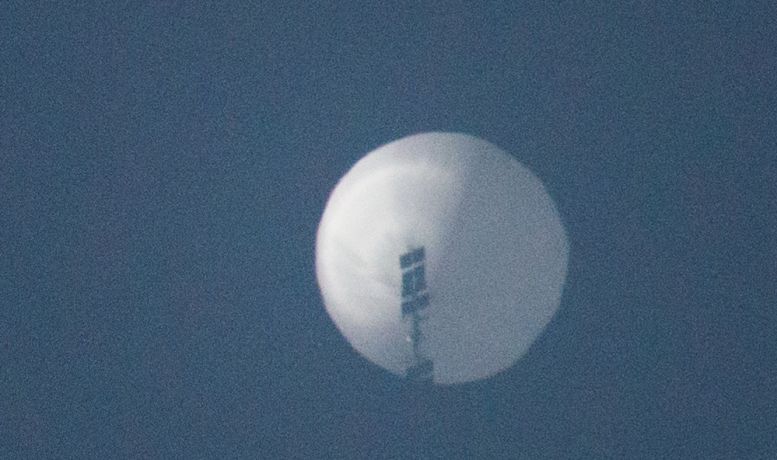On 4 February the US air force shot down a Chinese high-altitude balloon that had passed over its territory and the “balloon crisis” became a fact.
The Chinese government admitted the balloon belonged to it, saying it was a civilian weather balloon that had been blown off course and mistakenly entered US airspace. The Biden government angrily rejected China’s “accidental” explanation and used this as a pretext to cancel Secretary of State Blinken’s impending visit to Beijing, the first by a US Secretary of State for over four years and designed to be an “ice breaking” mission to de-escalate US-China tensions which have reached their highest point in over five decades.
US officials refused to apologize for shooting down China’s balloon and then three other unidentified flying objects (at least one reportedly a cheap hobby balloon) were shot down by US jets over US and Canadian territory. Subsequently, the US government stated these downed objects were not connected to China.
Ordinary people cannot trust what either side says. Their statements are propaganda crafted to suit their own class (imperialist) interests. Of course, China is spying on the US and vice versa. The Chinese balloon was almost certainly connected to the country’s military espionage programs. This cannot be news to anybody in the year 2023.
In 2013, US whistle-blower and former NSA operative Edward Snowden leaked classified documents which showed the US intelligence services had bugged the phones of 35 world leaders including, allegedly, the German leader Angela Merkel, a key US ally. Balloons represent a relatively low-tech aspect of this ongoing mutual espionage. For context, every single day 1,800 weather balloons are launched around the world. The US military obviously could not continue shooting at every unidentified object in US airspace.
Many people have also seen a farcical side to this drama. Top US official Karine Jean-Pierre felt the need to assure the press, “There is no indication of aliens or extraterrestrial activity” with the balloons.
Ratcheting up tensions
The balloon crisis has been exploited by the US side to significantly ratchet up tensions with Beijing, further amplifying its pressure on Xi Jinping’s dictatorship. Not least this was used to blunt China’s diplomatic manoeuvres in launching a “peace plan” on the first anniversary of Russia’s invasion of Ukraine on 24 February. Washington understands that Xi’s regime is even more anxious to cool down Cold War tensions in order to catch its breath amid a deepening economic, social and political crisis.
One possibility is that Xi may now want to strengthen the alliance with Russia, as part of an internal power struggle to placate China’s military hardliners. China’s holding back of support to Russia in the war in fear of US sanctions is not popular with ‘wolf warriors’ — aggressive anti-US nationalists. China and Russia have both suffered significant economic setbacks so they cannot offer each other much in terms of additional economic agreements, but they desperately need each other to defend their own geopolitical interests.
The US has countered this with high-profile warnings (not backed up by any evidence) that if China provides military aid to Russia, it will face an escalation of sanctions. The appearance of China’s senior foreign emissary Wang Yi beside Putin in Moscow, and Joe Biden alongside Zelensky in Kyiv, on the same day (February 20), was clearly not a coincidence. This was deliberate Cold War messaging by the two superpowers. However, China is unlikely to provide military aid to Russia for fear of US retaliation.
The turn in Chinese diplomacy which came after the CCP’s (so-called Communist Party’s) 20th Congress last October, with a muzzle at least temporarily put on the “wolf warriors,” is for tactical reasons and does not represent a fundamental shift of policy. Xi’s aim is to try to buy time and especially to try to repair some of the economic damage his hardline policies (such as support for Putin) have caused to China’s standing with European capitalist governments.
This tactical switch is unlikely to win any real benefits for Xi. The US-China Cold War is not ultimately caused by “hard” or “soft” diplomacy, or by the role of top leaders such as Xi or Biden (or Trump). It is caused by the irreconcilable contradictions of imperialist capitalism: the life-or-death struggle of two failing, crisis-ridden imperialist superpowers.
The US side seized upon the balloon incident to launch a new anti-China offensive. On balance, this has been a new politically costly setback for Xi’s regime. Blinken’s sudden cancellation of his scheduled visit to China threw a spanner in the works of Xi’s tactical shift to create an illusion of stabilising relations in order to stem the tide of Western economic decoupling from China. Biden’s government shared intelligence on the Chinese “balloon threat” with 40 other governments, to further cement their adherence to the US-led camp.
The background is one of serious setbacks for Xi and the CCP in 2022. Utilising the brutal Russian invasion of Ukraine as a pretext, US imperialism has strengthened and expanded NATO and other pro-US military alliances with vastly increased military expenditure and new formal treaty allies. The Biden administration has also increased pressure on the CCP over Taiwan, global supply chains and technology.
Tech war
The US has also made its allies more dependent on its own economy by strengthening military technological links. In October last year, the Biden administration announced draconian semiconductor export controls against China. At the end of the year, it wooed Japan and the Netherlands (both top makers of machinery critical to the manufacture of advanced microchips) into this new semiconductor bloc, and then further tightened the restrictions on chip exports to China.
This has undoubtedly dealt a serious blow to China’s plans for industrial upgrading and technological development including military modernization, which is the main aim of the US measures. Tech experts estimate this policy has set China back by one to two decades in its quest to develop cutting-edge microchips which are needed in A.I., advanced robotics and supercomputers — fields that could decide the new imperialist Cold War.
Against the background of sluggish domestic consumption, a historic housing slump and weakening of exports, Xi Jinping has been under increasing pressure to soften his Cold War stance and try to bring about a truce between the two sides, as a means to reignite China’s economic growth and defuse the time bomb of new mass protests.
But US capitalism is also becoming increasingly anxious over Ukraine, especially after the end of winter when the Russian and Ukrainian armies are likely to break out fierce new offensives. Possible setbacks for the Ukrainian side could widen splits among its Western backers with some of Biden’s European allies more inclined to look for compromise and a possible negotiated settlement.
One of the purposes of Blinken’s visit to China would have been to reopen communication channels and build “guard rails” into the relationship between US and Chinese imperialism, thus to try to establish some controls and limits over a conflict that risks to become uncontrollable. For now, the US ruling class prefers to consolidate its current relative upper hand, to put it in the strongest possible position before further escalating the conflict with China, for example by precipitating a possible military clash over Taiwan. For these reasons, the likelihood is that new approaches will be made in coming months to reschedule direct talks between Chinese and US officials.
Blinken did meet Wang Yi on the side-lines of the Munich Security Conference on February 18 — a fiery meeting that was compared to their 2021 encounter in Alaska (a veritable shouting match between the two sides). Biden has hinted at a new upcoming phone call with Xi Jinping. These exchanges can give a superficial appearance of stabilizing relations between the imperialist giants, but there can be no real stability in our age of capitalist and imperialist disorder and therefore any such intervals are likely to break down with new crisis flare-ups.
Splits in ruling class
For its part, Beijing seems to have been trying to tone down the balloon incident as much as possible. After the nationwide mass protests at the end of last year, Xi’s dictatorship suffered a huge collapse of authority. This was then compounded by Xi’s chaotic decision to let the coronavirus rip, killing possibly two million Chinese in the past three months.
Some people even speculate whether the balloon incident was instigated by hardliners in the People’s Liberation Army, with the purpose of undermining the process towards a diplomatic thaw in Sino-US relations. There is however no real evidence for this theory. Nonetheless, in both the US and China there are deep splits in the ruling class. In the US, Biden is under pressure from the Republican-controlled House of Representatives who accuse him of “weakness” against China and “not telling the truth” about the balloon incident and Chinese espionage. There is a high level of bipartisan agreement on confronting China, but to score points against each other the two Big Business parties bicker over the best approach.
The Republican’s House leader Kevin McCarthy plans to follow the example of his Democratic predecessor Nancy Pelosi by visiting Taiwan in coming months. Recent weeks, in the shadow of the balloon saga, have seen a raft of US initiatives that incrementally increase its direct role in the Taiwan Strait crisis. A token force of thirty US troops including special-operations forces, based on Taiwan in defiance of earlier US undertakings to Beijing, is now being boosted to as many as 200 troops. And on February 17, the Pentagon sent its top China official, Michael Chase, a deputy assistant secretary of defence, to Taiwan. These measures, as well as angering the Chinese regime, are designed to show US support for the militarisation policies of Taiwan’s DPP government, which include the enlargement of compulsory military service and increasingly authoritarian media and political restrictions.
The balloon crisis underlines the fragility of global relations and the risks of imperialist tensions getting out of control. The working-class movement needs to see this new warning sign as conclusive proof that we need revolutionary system change to end imperialism and militarism. We cannot trust capitalist politicians in the US, China or elsewhere to safeguard our lives and the planet’s future. We need socialist change on an international scale to demilitarise our world, overcome nationalist divisions and war-mongering, and liberate humankind from dictatorship and capitalist exploitation.


